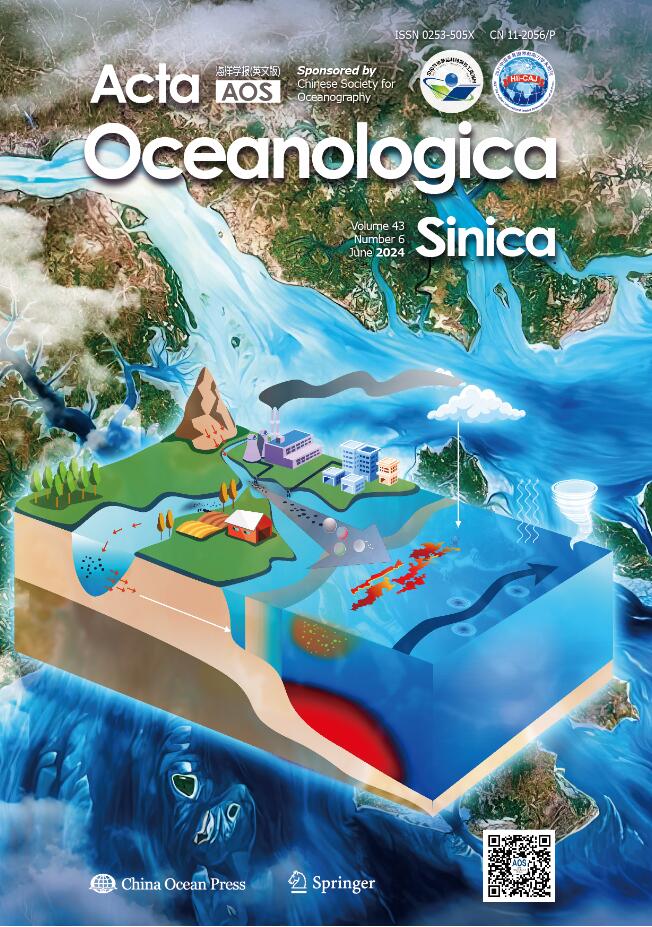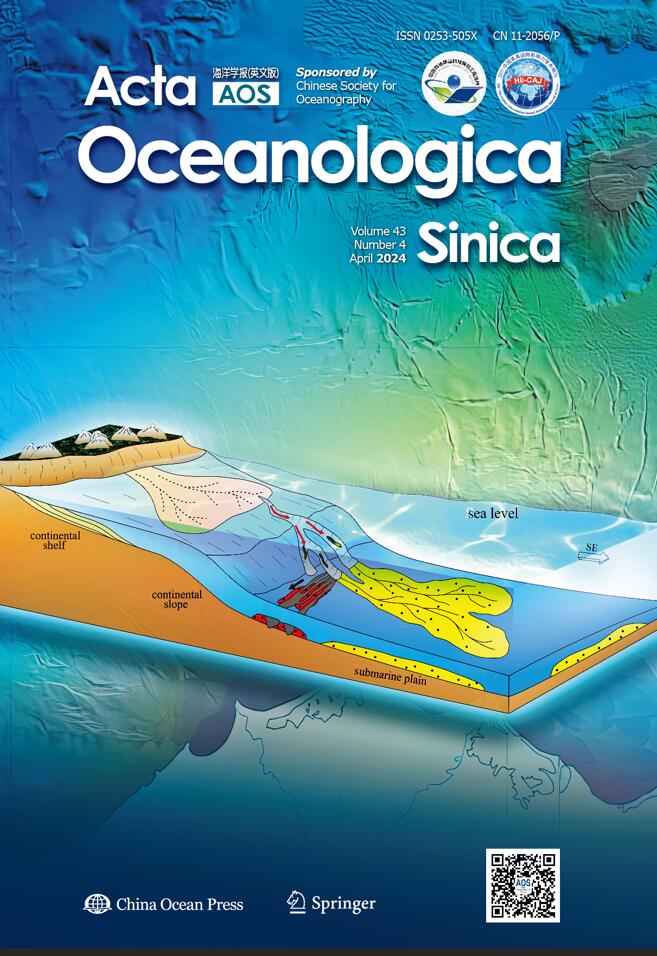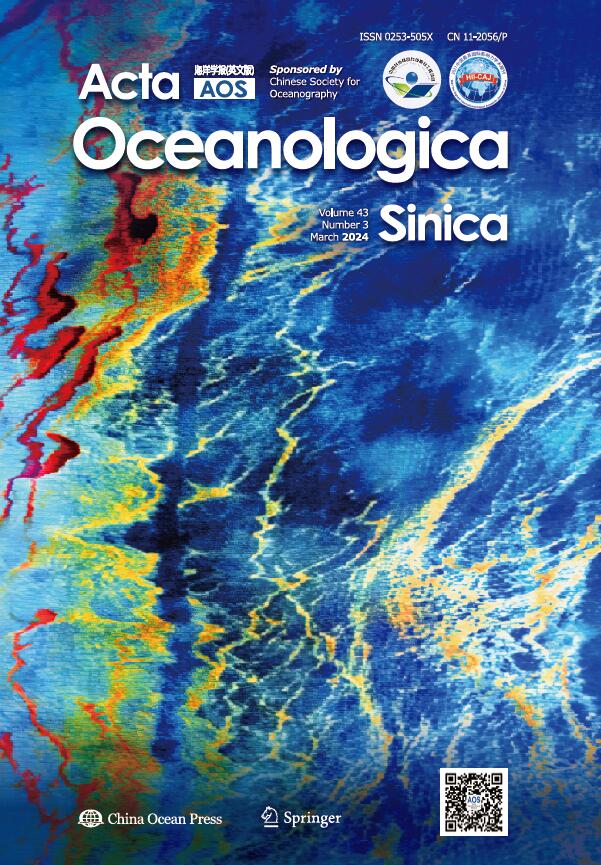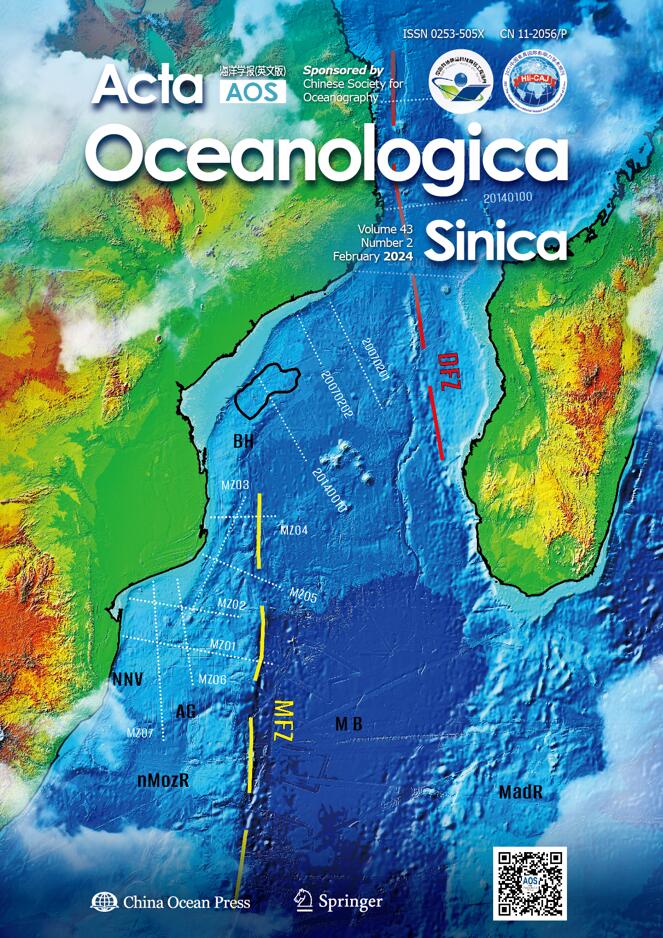Latest Articles
Articles in press have been peer-reviewed and accepted, which are not yet assigned to volumes/issues, but are citable by Digital Object Identifier (DOI).
Display Method:
, Available online , doi: 10.1007/s13131-024-2356-1
Abstract:
Mangroves are indispensable to coastlines, maintaining biodiversity, and mitigating climate change. Therefore, improving the accuracy of mangrove information identification is crucial for their ecological protection. Aiming at the limited morphological information of synthetic aperture radar (SAR) images, which is greatly interfered by noise, and the susceptibility of optical images to weather and lighting conditions, this paper proposes a pixel-level weighted fusion method for SAR and optical images. Image fusion enhanced the target features and made mangrove monitoring more comprehensive and accurate. To address the problem of high similarity between mangrove forests and other forests, this paper is based on the U-Net convolutional neural network, and an attention mechanism is added in the feature extraction stage to make the model pay more attention to the mangrove vegetation area in the image. In order to accelerate the convergence and normalize the input, batch normalization (BN) layer and Dropout layer are added after each convolutional layer. Since mangroves are a minority class in the image, an improved cross-entropy loss function is introduced in this paper to improve the model’s ability to recognize mangroves. The AttU-Net model for mangrove recognition in high similarity environments is thus constructed based on the fused images. Through comparison experiments, the overall accuracy of the improved U-Net model trained from the fused images to recognize the predicted regions is significantly improved. Based on the fused images, the recognition results of the AttU-Net model proposed in this paper are compared with its benchmark model, U-Net, and the Dense-Net, Res-Net, and Seg-Net methods. The AttU-Net model captured mangroves’ complex structures and textural features in images more effectively. The average OA, F1-score, and Kappa coefficient in the four tested regions were 94.406%, 90.006%, and 84.045%, which were significantly higher than several other methods. This method can provide some technical support for the monitoring and protection of mangrove ecosystems.
Mangroves are indispensable to coastlines, maintaining biodiversity, and mitigating climate change. Therefore, improving the accuracy of mangrove information identification is crucial for their ecological protection. Aiming at the limited morphological information of synthetic aperture radar (SAR) images, which is greatly interfered by noise, and the susceptibility of optical images to weather and lighting conditions, this paper proposes a pixel-level weighted fusion method for SAR and optical images. Image fusion enhanced the target features and made mangrove monitoring more comprehensive and accurate. To address the problem of high similarity between mangrove forests and other forests, this paper is based on the U-Net convolutional neural network, and an attention mechanism is added in the feature extraction stage to make the model pay more attention to the mangrove vegetation area in the image. In order to accelerate the convergence and normalize the input, batch normalization (BN) layer and Dropout layer are added after each convolutional layer. Since mangroves are a minority class in the image, an improved cross-entropy loss function is introduced in this paper to improve the model’s ability to recognize mangroves. The AttU-Net model for mangrove recognition in high similarity environments is thus constructed based on the fused images. Through comparison experiments, the overall accuracy of the improved U-Net model trained from the fused images to recognize the predicted regions is significantly improved. Based on the fused images, the recognition results of the AttU-Net model proposed in this paper are compared with its benchmark model, U-Net, and the Dense-Net, Res-Net, and Seg-Net methods. The AttU-Net model captured mangroves’ complex structures and textural features in images more effectively. The average OA, F1-score, and Kappa coefficient in the four tested regions were 94.406%, 90.006%, and 84.045%, which were significantly higher than several other methods. This method can provide some technical support for the monitoring and protection of mangrove ecosystems.
, Available online , doi: 10.1007/s13131-024-2343-6
Abstract:
The complexity of river-tide interaction poses a significant challenge in predicting discharge in tidal rivers. Long short-term memory (LSTM) networks excel in processing and predicting crucial events with extended intervals and time delays in time series data. Additionally, the sequence-to-sequence (Seq2Seq) model, known for handling temporal relationships, adapting to variable-length sequences, effectively capturing historical information, and accommodating various influencing factors, emerges as a robust and flexible tool in discharge forecasting. In this study, we introduce the application of LSTM-based Seq2Seq models for the first time in forecasting the discharge of a tidal reach of the Changjiang River (Yangtze River) Estuary. This study focuses on discharge forecasting using three key input characteristics: flow velocity, water level, and discharge, which means the structure of multiple input and single output is adopted. The experiment used the discharge data of the whole year of 2020, of which the first 80% is used as the training set, and the last 20% is used as the test set. This means that the data covers different tidal cycles, which helps to test the forecasting effect of different models in different tidal cycles and different runoff. The experimental results indicate that the proposed models demonstrate advantages in long-term, mid-term, and short-term discharge forecasting. The Seq2Seq models improved by 6%–60% and 5%–20% of the relative standard deviation compared to the harmonic analysis models and improved back propagation neural network models in discharge prediction, respectively. In addition, the relative accuracy of the Seq2Seq model is 1% to 3% higher than that of the LSTM model. Analytical assessment of the prediction errors shows that the Seq2Seq models are insensitive to the forecast lead time and they can capture characteristic values such as maximum flood tide flow and maximum ebb tide flow in the tidal cycle well. This indicates the significance of the Seq2Seq models.
The complexity of river-tide interaction poses a significant challenge in predicting discharge in tidal rivers. Long short-term memory (LSTM) networks excel in processing and predicting crucial events with extended intervals and time delays in time series data. Additionally, the sequence-to-sequence (Seq2Seq) model, known for handling temporal relationships, adapting to variable-length sequences, effectively capturing historical information, and accommodating various influencing factors, emerges as a robust and flexible tool in discharge forecasting. In this study, we introduce the application of LSTM-based Seq2Seq models for the first time in forecasting the discharge of a tidal reach of the Changjiang River (Yangtze River) Estuary. This study focuses on discharge forecasting using three key input characteristics: flow velocity, water level, and discharge, which means the structure of multiple input and single output is adopted. The experiment used the discharge data of the whole year of 2020, of which the first 80% is used as the training set, and the last 20% is used as the test set. This means that the data covers different tidal cycles, which helps to test the forecasting effect of different models in different tidal cycles and different runoff. The experimental results indicate that the proposed models demonstrate advantages in long-term, mid-term, and short-term discharge forecasting. The Seq2Seq models improved by 6%–60% and 5%–20% of the relative standard deviation compared to the harmonic analysis models and improved back propagation neural network models in discharge prediction, respectively. In addition, the relative accuracy of the Seq2Seq model is 1% to 3% higher than that of the LSTM model. Analytical assessment of the prediction errors shows that the Seq2Seq models are insensitive to the forecast lead time and they can capture characteristic values such as maximum flood tide flow and maximum ebb tide flow in the tidal cycle well. This indicates the significance of the Seq2Seq models.
, Available online , doi: 10.1007/s13131-024-2313-z
Abstract:
The deltas serve as the primary interactive zone where terrestrial and marine environments converge, playing a pivotal role in the coastal deposition. In the Holocene, climate changes and sea level fluctuation are the principal driving factors in the evolution of deltas. However, human activities such as the construction of dams and reservoirs in the Anthropocene have significantly altered sediment transport in rivers, leading to depositional pattern variation during deltaic evolution. In this study, we have conducted a comparative analysis of the morphological variations (1986–2021) in the barrier system of the Hanjiang River Delta (HRD) using satellite remote sensing (SRS) method. Additionally, we have examined the lithological changes and facies alterations observed in eight boreholes on the present barrier spit. Our findings indicate that the intensification of anthropogenic activities led to a significant reduction in the sediment flux of the Hanjiang River (HR), resulting in depocenter landward migration at the estuary. SRS analysis reveals their periodical morphological characteristics and spatial variations of estuarine sandbars (1986–1992), barrier islands-lagoons (1993–2009), and barrier spits (2010–2021) during 1986 to 2021. The stratigraphy of boreholes demonstrates a south-to-north facies transition from lagoon to lagoon-barrier spit and barrier spit in vertical lithology. Therefore, the depositional evolution of the HRD barrier system is categorized into three phases: estuarine sandbar-barrier island phase (1986–1998); barrier island-lagoon phase (1999–2009); and barrier spit phase (2010–2021). During the estuarine sandbar-barrier island phase, fluvial processes played a predominate role in the deposition. Consequently, with a significant decrease in river sediment load, the dominant factors driving depositional processes shifted towards wave action and alongshore current. Based on the conceptual model in the Holocene, we propose a modified depositional model of wave-dominated deltas during Anthropocene that encompasses three evolutionary phases: estuarine sandbars and delta front platforms, barrier island-lagoon formation and landward migration of barrier spits. This pattern highlights that human-induced reduction in river sediment flux has led to a seaward deltaic progradation driven by barrier landward migration.
The deltas serve as the primary interactive zone where terrestrial and marine environments converge, playing a pivotal role in the coastal deposition. In the Holocene, climate changes and sea level fluctuation are the principal driving factors in the evolution of deltas. However, human activities such as the construction of dams and reservoirs in the Anthropocene have significantly altered sediment transport in rivers, leading to depositional pattern variation during deltaic evolution. In this study, we have conducted a comparative analysis of the morphological variations (1986–2021) in the barrier system of the Hanjiang River Delta (HRD) using satellite remote sensing (SRS) method. Additionally, we have examined the lithological changes and facies alterations observed in eight boreholes on the present barrier spit. Our findings indicate that the intensification of anthropogenic activities led to a significant reduction in the sediment flux of the Hanjiang River (HR), resulting in depocenter landward migration at the estuary. SRS analysis reveals their periodical morphological characteristics and spatial variations of estuarine sandbars (1986–1992), barrier islands-lagoons (1993–2009), and barrier spits (2010–2021) during 1986 to 2021. The stratigraphy of boreholes demonstrates a south-to-north facies transition from lagoon to lagoon-barrier spit and barrier spit in vertical lithology. Therefore, the depositional evolution of the HRD barrier system is categorized into three phases: estuarine sandbar-barrier island phase (1986–1998); barrier island-lagoon phase (1999–2009); and barrier spit phase (2010–2021). During the estuarine sandbar-barrier island phase, fluvial processes played a predominate role in the deposition. Consequently, with a significant decrease in river sediment load, the dominant factors driving depositional processes shifted towards wave action and alongshore current. Based on the conceptual model in the Holocene, we propose a modified depositional model of wave-dominated deltas during Anthropocene that encompasses three evolutionary phases: estuarine sandbars and delta front platforms, barrier island-lagoon formation and landward migration of barrier spits. This pattern highlights that human-induced reduction in river sediment flux has led to a seaward deltaic progradation driven by barrier landward migration.














